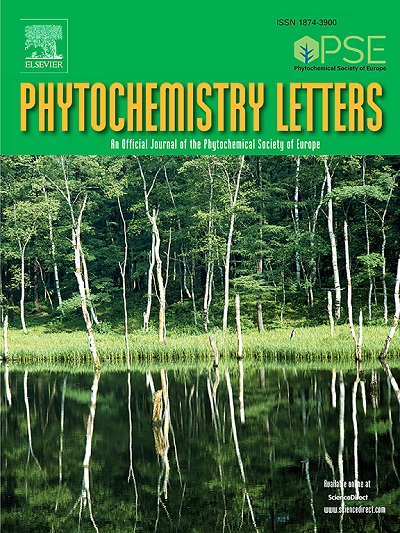积雪草叶片内生真菌侧生真菌次生代谢产物的植物毒性研究
IF 1.4
4区 生物学
Q4 CHEMISTRY, MEDICINAL
引用次数: 0
摘要
从药用植物积雪草(Centella asiatica)的叶片中分离得到一株内生真菌,经分子鉴定为侧生木耳(Muyocopron laterale)。在马铃薯葡萄糖肉汤培养基中培养真菌。5周后,用乙酸乙酯提取肉汤和菌丝。经色谱分离得到两种新的聚酮,分别命名为muyokoyrone(3)和muyokoenone(5),以及四种已知的化合物,austdiol(1), 4-(羟甲基)-3-甲氧基-5-甲基环戊烯-2-烯酮(2),eugentin(4)和6-甲氧基甲基eugenin(6)。将发酵液喷在黄瓜叶片上时,显示出坏死和萎蔫症状。在黄瓜叶片穿刺试验中,肉汤和菌丝体的乙酸乙酯提取物均表现出坏死症状。肉汤中乙酸乙酯提取物对莴苣种子萌发的IC50值分别为23.7 μg/mL和55.8 μg/mL。化合物1对生菜种子的根伸长有抑制作用,IC50值为5.38 μg/mL,而化合物1和2在叶片穿刺试验中表现出坏死症状。本文章由计算机程序翻译,如有差异,请以英文原文为准。
Phytotoxicity of secondary metabolites from a fungal endophyte Muyocopron laterale isolated from leaves of Centella asiatica
An endophytic fungus isolated from the leaves of a common medicinal plant, Centella asiatica, was identified as Muyocopron laterale through molecular means. The fungus was cultured in potato dextrose broth medium. After five weeks, the broth and mycelium were extracted with EtOAc. Chromatographic separation of the combined EtOAc extract yielded two new polyketides, named muyokopyrone (3) and muyokoenone (5), along with four known compounds, austdiol (1), 4-(hydroxymethyl)-3-methoxy-5-methylcyclopent-2-enone (2), eugenitin (4) and 6-methoxymethyl eugenin (6). The fermentation broth showed necrotic and wilting symptoms when sprayed on the leaves of cucumber (Cucumis sativus) plants. The EtOAc extracts of the broth and mycelium showed necrotic symptoms in the leaf puncture assay using cucumber leaves. The EtOAc extract of the broth inhibited root and shoot elongation with IC50 values of 23.7 μg/mL and 55.8 μg/mL, respectively in the lettuce seed germination assay. Compound 1 inhibited root elongation of lettuce seeds with an IC50 value of 5.38 μg/mL while compounds 1 and 2 showed necrotic symptoms in the leaf puncture assay.
求助全文
通过发布文献求助,成功后即可免费获取论文全文。
去求助
来源期刊

Phytochemistry Letters
生物-生化与分子生物学
CiteScore
3.00
自引率
11.80%
发文量
190
审稿时长
34 days
期刊介绍:
Phytochemistry Letters invites rapid communications on all aspects of natural product research including:
• Structural elucidation of natural products
• Analytical evaluation of herbal medicines
• Clinical efficacy, safety and pharmacovigilance of herbal medicines
• Natural product biosynthesis
• Natural product synthesis and chemical modification
• Natural product metabolism
• Chemical ecology
• Biotechnology
• Bioassay-guided isolation
• Pharmacognosy
• Pharmacology of natural products
• Metabolomics
• Ethnobotany and traditional usage
• Genetics of natural products
Manuscripts that detail the isolation of just one new compound are not substantial enough to be sent out of review and are out of scope. Furthermore, where pharmacology has been performed on one new compound to increase the amount of novel data, the pharmacology must be substantial and/or related to the medicinal use of the producing organism.
 求助内容:
求助内容: 应助结果提醒方式:
应助结果提醒方式:


